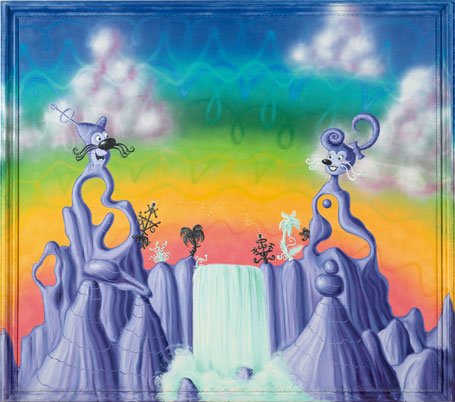On viewing art and accepting contradiction

Oil and spray paint on canvas. 91 1/2 x 103 1/2 inches.
Courtesy of Paul Kasmin Gallery, New York and Honor Fraser Gallery, Los Angeles. © Kenny Scharf/Artists Rights Society (ARS), New York
The arts world had fun last month with Washington Post art critic Phillip Kennicott’s “How to View Art.” Kennicott proffered advice on how he believes one should experience art, and put forward five rules. Tips involved seemingly uncontroversial, although not always practical suggestions such as “take your time” and “seek silence,” as well as some less easy-to-adapt practices such as “study up,” “engage the art through memory” and “accept contradiction.”
Since everything is divisive these days, Kennicott’s piece stirred up a healthy discussion, predominantly among a certain segment of the arts media dominated by younger writers who argued in favor of the museum selfie, and an approach to art viewing that doesn’t involve mental exertion.
It boils down, to some extent, to a simple dichotomy between the populist, democratic subset of arts lovers who argue that we shouldn’t try to explain art and should just enjoy it, and those, like Kennicott, who argue that viewing art isn’t supposed to be easy.
Depending on the day, and the artist, I place myself firmly in both camps, a position which necessarily entails a high level of cognitive dissonance. Kennicott’s challenge to accept the contradiction inherent in embracing contemporary art allows at least a semblance of peace for those of us who regularly grapple with the challenge of making sense of the implicit contradictions inherent in a love of art’s intellectualism.
Take for example, the Whitney Museum of American Art’s recently closed retrospective of Jeff Koons’ career. Koons and his work are perhaps the perfect example of an art that can be interpreted as highly symbolic, or merely aesthetic, depending on one’s knowledge and experience of the man and his practice. His inflatables and cast sculptures can certainly be read as the artist’s attempt to democratize culture, normalize divergent behavior and find beauty in the mundane. But his work can just as easily be interpreted solely through our individual experience with it; the memories it evokes. As Koons himself has said, “I create art to inspire feelings” and to allow each individual to find their own “possibility” with art.
What about the work on view in the Fort Worth Modern’s Urban Theater exhibition, which also features some of Koons work? On a recent visit, Kenny Scharf’s “Cosmic Cavern” attracted a queue full of children and parents (who I can only assume are not explaining to their children Scharf’s intention to subvert our notions of fine art by injecting it with elements of street culture and cartoons). Seeing Scharf’s art in a fine art museum, like Koons’ and so many of their contemporaries, is a contradiction in itself; their aggressive attacks on elitism functioning as a wholehearted rejection of the art establishment which now glorifies them.
It’s all a part of the endless debate, does the artist ascribe meaning, or does the audience intuit it? And shouldn’t it be obvious to us all at this point in our cultural history that some debates will never go away?
Cognitive dissonance, as anyone who does a lot of thinking is sure to attest, is a rather frustrating reality. How can I agree with Susan Sontag’s argument against interpretation and in favor of emotional response, and, at the same time, share Kennicott’s belief that “our response to art is directly proportional to our knowledge of it”?
For me, viewing art will always be the most emotional and intellectual pursuit I regularly undergo, and, if I’m being perfectly honest, I wish everyone attacked the gallery as I do. However, in my perpetual struggle to suppress my inner elitism, I recognize and appreciate that others less inclined towards mental struggle can appreciate and enjoy art as well, and perhaps even more than I do. Is it a contradiction? Yes. But, as with life, the beauty of art often rests perfectly in its contradiction.
-JENNIFER SMART

